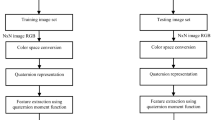Abstract
Color is one of the basic features of images, which can provide very useful information and play an important role in face recognition. By using the quaternion matrix representation, the R, G, B information of each pixel is not destroyed and it can be taken as a organic body. Therefore, this paper proposes a quaternion based maximum margin criterion (QMMC) algorithm. Firstly, the quaternion number is used to denote the pixel of the color image, and a quaternion vector is taken to represent the color image. Secondly, the maximum margin criterion algorithm is used to project the quaternion vector in the high-dimension space into a low-dimension space. Finally, the nearest neighbor classification are taken for classification recognition. Numerous experiments show that the proposed QMMC can achieve better recognition performance.






Similar content being viewed by others
References
Liu T, Tao D (2016) Classification with noisy labels by importance reweighting. IEEE Trans Pattern Anal Mach Intell 38(3):447–461
Xu Y, Zhang D, Yang J, Yang JY (2011) A two-phase test sample sparse representation method for use with face recognition. IEEE Trans Circuit Syst Video Technol 21(9):1255–1262
Liu T, Tao D (2015) On the performance of manhattan nonnegative matrix factorization. IEEE Trans Neural Netw Learn Syst 27(9):1851–1863. doi:10.1109/TNNLS.2015.2458986
Xu Y, Zhong A, Yang J, Zhang D (2010) LPP solution schemes for use with face recognition. Pattern Recognit 43:4165–4176
Tao D, Song M, Li X, Shen J (2008) Bayesian tensor approach for 3-D face modelling. IEEE Trans Circuit Syst Video Technol 18(10):1397–1410
Xu Y, Li X, Yang J, Lai Z, Zhang David (2014) Integrating conventional and inverse representation for face recognition. IEEE Trans Cybern 44(10):1738–1746
Xu C, Tao D, Xu C, Rui Y (2014) Large-margin weakly supervised dimensionality reduction. In: Proceedings of the 31st International Conference on Machine Learning (ICML-14), pp 865–873
Yu J, Tao D et al (2015) Learning to rank using user clicks and visual features for image retrieval. IEEE Trans Cybern 45(4):767–779
Xu C, Tao D, Xu C (2014) Large-margin multi-view information bottleneck. IEEE Trans Pattern Anal Mach Intell 36(8):1559–1572
Xu Y, Zhang D, Yang JY (2010) A feature extraction method for use with bimodal biometrics. Pattern Recognit 43(3):1106–1115
Yu J, Rui Y et al (2014) Click prediction for web image reranking using multimodal sparse coding. IEEE Trans Image Process 23(5):2019–2032
Xu C, Tao D, Li Y, Xu C (2013) Large-margin multi-view Gaussian process for image classification. In: Proceedings of the Fifth International Conference on Internet Multimedia Computing and Service, pp 7–12
Yu J, Rui Y et al (2014) High-order distance-based multiview stochastic learning in image classification. IEEE Trans Cybern 44(12):2431–2442
Suhre A, Kose K, Cetin AE, Gurcan MN (2011) Content-adaptive color transform for image compression. Opt Eng 50(5):057003
Yuan Y, Zhang J, Chang B, Han Y (2011) Objective quality evaluation of visible and infrared color fusion image. Opt Eng 50(3):033202
Torres L, Reutter J, Lorente L (1999) The importance of the color information in face recognition. In: Proceedings International Conference on Image Processing, vol. 3, pp 627–631
Rajapakse M, Tan J, Rajapakse J (2004) Color channel encoding with NMF for face recognition. In: Proceedings of IEEE International Conference on Image Processing, pp 2007–2010
Yang J, Liu C (2008) Color image discriminant models and algorithms for face recognition. IEEE Trans Neural Netw 19:2088–2098
Liu C (2008) Learning the uncorrelated, independent, and discriminating color spaces for face recognition. IEEE Trans Inf Forens Secur 3(2):213–222
Wang C, Yin B, Bai X, Sun Y (2008) Color face recognition based on 2DPCA. In: Proceeding 19th International Conference on Pattern Recognition, pp 1–4
Yang J, Liu C, Zhang L (2010) Color space normalization: enhancing the discriminating power of color space for face recognition. Pattern Recognit 43(4):1454–1466
Wang SJ, Yang J (2012) Sparse tensor discriminant color space for face verification. IEEE Trans Neural Netw Learn Syst 23(6):876–887
Villegas M, Paredes R, Juan A, Vidal E (2008) Face verification on color images using local features. In Proceeding IEEE Computer Society Conference Computer Vision Pattern Recognition Workshops, pp 1–6
Hamilton WR (1866) Elements of quaternions. Longmans, Green and Co, London
Lang F, Zhou J, Yan B, Song E (2008) Obtain method of quaternion matrix orthogonal eigenvector set and its application in color face recognition. Acta Autom Sin 34(2):121–129 (in Chinese)
Javier V, Palomar DP, Luis V, Ignacio S (2011) Quaternion ICA from second-order statistics. IEEE Trans Signal Process 59(4):1586–1600
Li H, Jiang T (2006) Efficient and robust feature extraction by maximum margin criterion. IEEE Trans Neural Netw 17(1):157–165
Tian Y (2000) Matrix theory over the complex quaternion algebra. ArXiv mathematics e-prints. http://arxiv.org/abs/math/0004005
Xu Y (2012) Quaternion-based discriminant analysis method for color face recognition. PLOS One 7(8):e43493
Martinez A, Benavente R (1998) The AR face database. In: Technical Report 24, Centre de Visio per Computador, Univ. Purdue, West Lafayette
Acknowledgments
This work was partly supported by NSFC of China (U1504610, 61402274, 61672333), the Natural Science Foundations of Henan Province (14A413013, 142102210584, 13B520992), the Natural Science Foundations of Luoyang (1401036A), The Development Foundations of Henan University of Science and Technology (2014ZCX013), the Key Science and Technology Program of Shaanxi Province (No.2016GY-081).
Author information
Authors and Affiliations
Corresponding author
Rights and permissions
About this article
Cite this article
Liu, Z., Qiu, Y., Peng, Y. et al. Quaternion Based Maximum Margin Criterion Method for Color Face Recognition. Neural Process Lett 45, 913–923 (2017). https://doi.org/10.1007/s11063-016-9550-x
Published:
Issue Date:
DOI: https://doi.org/10.1007/s11063-016-9550-x




